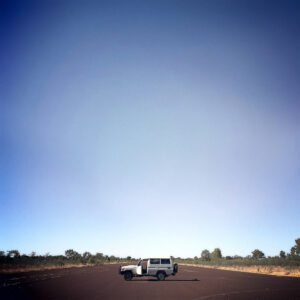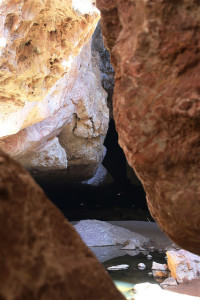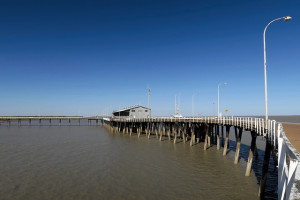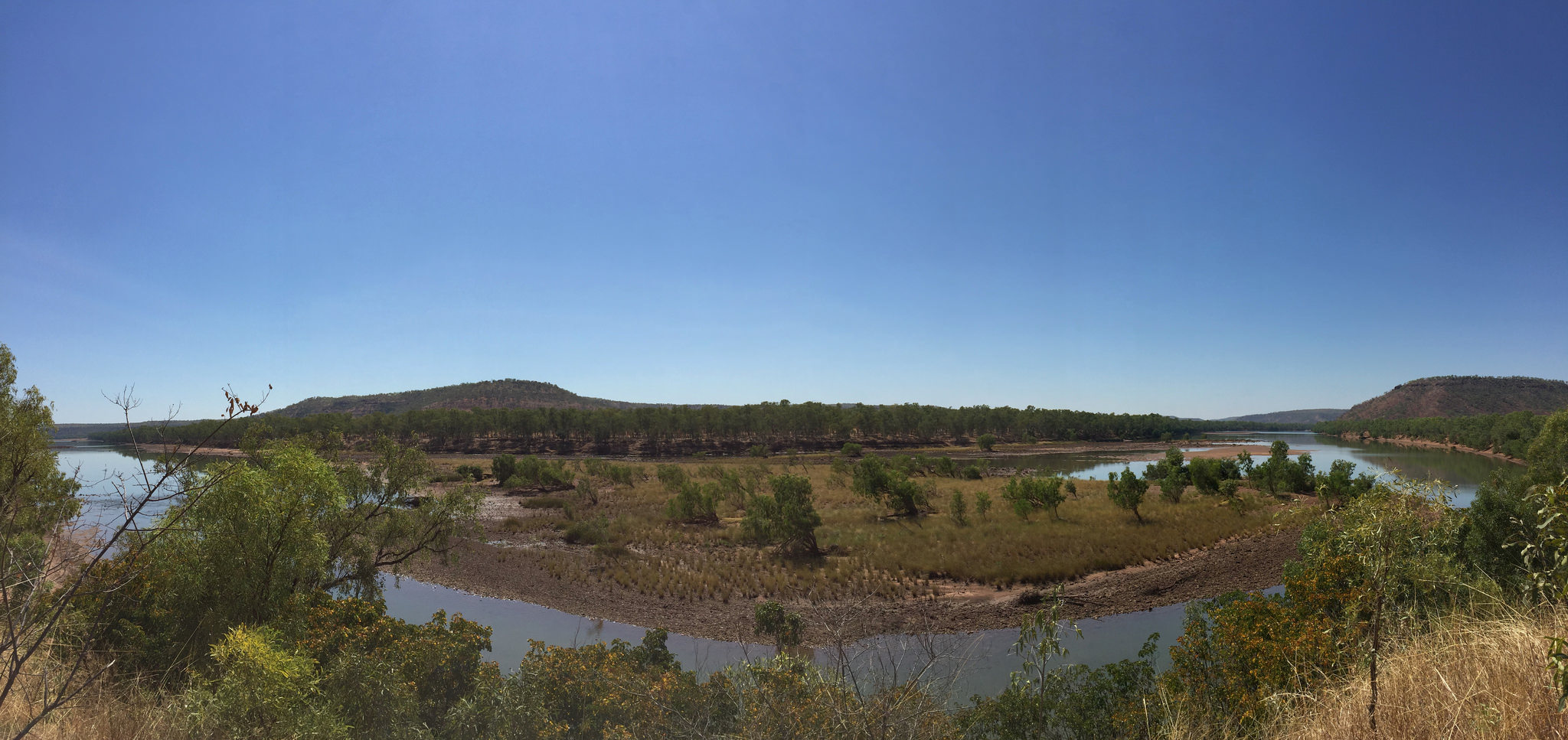We pick up our adventure where we left it: the long Diamantina Highway towards Mount Isa hasn’t much sightings after Bedourie.
An exception to that might be the little town of Boulia. We stayed around the racecourse, and were surprised to see so many people at this (free) campspot. Although around this time of year (July/August) we expected more travellers than usual, but this spot was packed with people who clearly had their spot marked and would do anything to protect it. Seeing camels in paddocks and racers on top of camels explained a lot for itself: we were just a few days ahead of the famous Boulia Camel Races.
You must know races are held with all kinds of animals, especially in Queensland. Around this time of year there must also be a pig race (!!). These camel races are apparently the richest (read: biggest prize money) professional camel races in Queensland (so there must be more than just this one). Boulia is also know for the Min Min Light. The legend lives from 1912, when a stockman saw a strange and moving light at the Min Min graveyard that seemed to follow him. The light has been reported every now and then ever since. We got ourselves a spot in the dark, but didn’t see any other light than our headlights.
From Boulia, the country starts to show some more green again. The closer we got to Mount Isa, the more trees and actual bush we noticed. And the road starts to wind a bit more, instead of ever going straight. Mount Isa is very recognizable because of the chimneys of the mines, which are seen from far before the city. Yes, a city in the outback! With traffic lights … Oh gosh, so busy  compared to all the towns we’ve been through for weeks now. If you want to know more about Mount Isa, just read the blogpost we wrote about our road trip in 2013/2014.
compared to all the towns we’ve been through for weeks now. If you want to know more about Mount Isa, just read the blogpost we wrote about our road trip in 2013/2014.
Some quick facts? Mount Isa is the second biggest city (in square kilometers) in Australia. It’s all about mining: gold, silver, lead, zinc are found underneath. They have an underground hospital (and an underground mining tour). And of course there is a rodeo show every year (it hasn’t have to be races every time). More important for us: we met our lovely friends from Melbourne … A chance coincidence: we noticed some drops of some substance underneath the car, at the day we were about to get going, which we didn’t trust.
So we had to get it checked (and luckily we did – a broke waterpump would have caused us big problems further ahead …). Our friends also had some problems with their camper and also stayed a bit longer than foreseen around. So, while their car was fixed, and ours was taken care for, we caught up with a nice dinner and a play of Up and Down the River.
After a few days delay, we could finally leave and head further north west. This part of our journey didn’t have much secrets to us. We already drove along the Barkly Highway on our previous trip, but this was the shortest option to get to Katherine. We skipped some possible places to spend the night because of the never ending flies. So we planned to stay in Camooweal near the river,but we didn’t. If you’ve never been in this region, be sure though to spend some time in Camooweal, just out of Mount Isa, on the boarder with the Northern Territory. This is an absolute must-see place if you’re interested in the droving history of Australia.
And we must say, it is quite spectacular to see the drovers at work! We ended up at Barkly Homestead, which is 450 km east of Mount Isa. At Tree Ways (junction of the Barkly and Stuart Highway) we found ourselves back on the Stuart Highway, which would bring us further north to the tropics. Another nice free stop is Attack Creek. Located just next to the dry river bed, and some interesting facts about the days back in time when Europeans came to settle.  We found out Elliot is still as miserable as last time (don’t dare to go in the public toilets).
We found out Elliot is still as miserable as last time (don’t dare to go in the public toilets).
But we did check out Daly Waters better than we did last time. We stayed at the Daly Waters Hi-Way Inn, which is lot’s cheaper than the Daly Waters Pub in town (probably the Pub is just too touristy, it got’s mentioned in every travel guide …). And what a surprise to meet a compatriot in this middle-of-nowhere-place! Nice to speak some Flemish again! But we did go to see that famous pub! As we finally got to see the Stuart Tree. Or rather, what’s left of it … Which is just the trunk. But it is an official sighting, because Mister Stuart was so clever to carve an S in that trunk when he went out here on his exploring mission.
The ruins around the building are the Overland Telegraph Station. Another interesting place is the airfield, which played an important role during the Second World War. It’s also the first international airport of Australia, with flights going as far as London (we speak 1930’s and even a bit earlier!). Nowadays, you can walk freely in the old Qantas hangars. However, do take care when walking around here, especially at the wreckage of an airplane, which lays in high grass. The airfield is still in use for medical flights, and is used by the RAAF (who have bases around the region). It turns out Daly Waters is actually quite interesting. If you want to know more about other places along the Stuart Highway, please check back our previous blog posts.
We felt relieved to arrive in Katherine, although you couldn’t really call it ‘relief’. We did arrive in the tropics … Warm but oh so humid! Hello Top End! We spent some lovely days at the caravan park (the Big 4, which is the safest). We walked around the Katherine Hot Springs at the Katherine River. After some power napping, we set off to go west. Finally!
Katherine is the last big town before crossing the border with Western-Australia. This is a tricky trip. Not because of the road, but because of the border crossing. WA is extremely prudent with fruit and veggies. You’re not allowed to take anything fresh with you. We know there are border controls, so we made sure we counted everything fresh we had with us so we didn’t had to trow away too much. Although not high-season yet, the temperatures rose quite high. En route, we passed and drove through Gregory National Park. The road is long and sometimes boring, but this part is absolutely beautiful! The park encompasses the land of various indigenous groups, but is named after the explorer and inventor Gregory. This man has a giant boab tree named after him: Gregory’s Tree. It is a sacred site for the Ngarinyman people, known as a meeting and ceremony place for centuries.
It is a sacred site for the Ngarinyman people, known as a meeting and ceremony place for centuries.
The place also comes back in Dreamtime Stories: one of the traditional men travelled, covered with goanna spots and changed in Goanna Man. Once he got to this place, he changed in the boat tree. It got its western name because Augustus Gregory decided to camp at this beautiful place (high enough to avoid crocodile attacks from the giant Victoria River below). The expedition artist carved the dates of arrival and departure in the bast of the tree. If you go deeper into the park, you’ll also find rock art – common found in this region, and amazing relicts of the past. From Policeman’s Point you can see with your own eyes how big the Victoria River is. From there it is only a short drive to Timber Creek, our camp spot for the night (unfortunately we couldn’t find free camp spots with enough shade, so we drove on until Timber Creek, with a very shady caravan park).
The place got its name because our friend Gregory used timber from the banks of the creek to repair a boat. He could have easily called it Bat Creek. Just amazing how many big bats there were here! For many Australians these animals mean disease and dirt, but imagine how the world would like without them … Thank you for eating all those mosquitoes 🙂 The resident alligator was a bit boring compared to those flying foxes! The last stop before the border is Keep River National Park. It’s a whole lot smaller than Gregory NP, but nonetheless interesting to take a detour (and eat our last fruit and veggies). The Cockatoo Lagoon actually has cockatoos, but other birds as well and doesn’t dry up even in Dry Season). And we walked the Ginger’s Hill Walk (we didn’t go further, too hot). It is one of the aboriginal sites found here, and very interesting. We got to know how people used to hunt from the top of a hill … Very creative people!
Goodbye Northern Territory, hello WA! The check at the border wasn’t really that profound. We’ve could have hide some things and easily got away with it. Way too honest … From here we enter the Kimberley region (roughly everything north on the same latitude till Broome).
So, stock-up in Kununurra, the next ‘big’ town. In and around Kununurra are a few sightings. You could go to the Zebra Rock Gallery to see some kind of rare rock, Hidden Valley National Park (mini Bungles) and Lake Argyle (a huge lake with an infinity pool). We stayed at the caravan park, nearby the wetlands. Help, the mosquitoes where giant! But we saw some (sweet water) crocs. And a giant boab! These trees are common in the area, and yes, they are related to the Baobab trees in Madagascar. And the Latin name refers to … our friend Gregory! A strange fact: the tree blossoms during the early dry, but only for one day and overnight … The tree at the caravan park is considered to be 2000 years, a youngster amongst the family …
Wyndham, some hundred kilometers north (one way) is a recommended day-trip from Kununurra, because of the rare confluence of 5 rivers. But the best way to see this is from the air, which takes a lot from your travel budget … Another recommended day-trip goes to Purnululu National Park, also known as the Bungle Bungles. Giant rocks in the form of bee hives. But again, best seen from the air … We did stop at the entrance of the park, but decided not to go in (the entrance fee is quite high and the road in is very rough condition).
Yes, indeed, this means we didn’t drive the Gibb River Road … We heard from other people the Gibb was never in such a bad condition as then, and we didn’t want to risk ending up aside the road. Besides, this is a trip on dirt road which can take days if not weeks. However, from here, the temperature started to become normal again. . So we drove on towards the next stop, a free camp spot  along a nice river bed (but high enough in case of sudden water rise). Luckily we got here on time, the place filled up quick! Very nice atmosphere! Our route west continued along Fitzroy Crossing. From that place we decided to take a ‘short-cut’ along a off road track. Well, that so-called ‘short-cut’ was not as it seemed on the map! However we did got to see Tunnel Creek NP, the Leopold Downs Road is an absolute no-go for 2WD! Btw: were this road and the nearby Leopold Ranges CP named after our first king?
along a nice river bed (but high enough in case of sudden water rise). Luckily we got here on time, the place filled up quick! Very nice atmosphere! Our route west continued along Fitzroy Crossing. From that place we decided to take a ‘short-cut’ along a off road track. Well, that so-called ‘short-cut’ was not as it seemed on the map! However we did got to see Tunnel Creek NP, the Leopold Downs Road is an absolute no-go for 2WD! Btw: were this road and the nearby Leopold Ranges CP named after our first king?
The road started as a normal off road, a bit bumpy, but the further we got, the less we could enjoy the beautiful landscape (boab heaven!) … The dips were deep, the road itself desperate in need of a proper grader. Tunnel Creek on the other hand was wonderful! The car park was full, but they didn’t come from behind us … Anyway, the reason why people would even consider to come to this place along the worst road on earth is simpel: nature did a stunning job here! The creek – Tunnel Creek – flows through a tunnel (hence the name) under the limestone of the Napier Range, which is over 360 millions year old! The tunnel was created by the flowing water on top of the Range – the ground was higher than it is today. About 750 meters further, the water comes out again. And of course, there is a local story connected to this place: it was a hideout for several years for an Aboriginal freedom fighter (Jandamarra). A fascinating story …
We made it after a day on that terrible road for those wondering 🙂 Windjana Gorge NP will be for another time, we were absolute sick of it! But of what a surprise, we can actually say we drove on the Gibb River Road! The Leopold Downs Road comes together with the Gibb. So after another few kilometers we finally saw some bitumen again! Bummer it already ended after a few K’s, but than it came back, and so on and so on … We had a goal though that day: making it till Derby! We avoided a wallaby and some cars on the narrow road, and when we finally got a phone signal, we rang the caravan park we had in mind to hear we got the last spot! Never have we been more happy than to arrive, just before sunset, in the habited world, aka Derby!
 Exhausted from our day , we didn’t want to put much effort in dinner and had a quick sandwich. In the morning we first tried to arrange new accommodation (hard to find free camp spots in a town), but the caravan parks were too expensive or full. So we took in all the sightings of Derby in one day. The first thing we did after our failed attempt to find a place to sleep, was obvious: Derby has an enormous bay – King Sound. The jetty has always played an important role in the trade history of this place. First for wool and pearl shells; later live cattle, fuel, oil, commodities, zinc and lead were traded. Driving to the jetty, you’ll see the enormous mud flats.
Exhausted from our day , we didn’t want to put much effort in dinner and had a quick sandwich. In the morning we first tried to arrange new accommodation (hard to find free camp spots in a town), but the caravan parks were too expensive or full. So we took in all the sightings of Derby in one day. The first thing we did after our failed attempt to find a place to sleep, was obvious: Derby has an enormous bay – King Sound. The jetty has always played an important role in the trade history of this place. First for wool and pearl shells; later live cattle, fuel, oil, commodities, zinc and lead were traded. Driving to the jetty, you’ll see the enormous mud flats.
They are caused by the huge tides – the highest of Australia (up to 11 meters!). Derby has a lot of boab trees, but the most famous and by far the biggest is the Prison Tree. The tree is an Aboriginal site but was long used as a prison due to the giant whole in the middle of the trunk. It is believed Aboriginal people who were kidnapped, were hold captive in the tree before they were transported to pearling boats. This practice continued till the late 19th Century. From then on (Aboriginal) people were put away in the new gaol. For the aboriginal people, these trees (larrkardiy) have mystical forces. And the termite mounds, which are also found in abundance, are treated with the same respect. Apparently, indigenous people used to bury a deceased person in an active mound. And both the trees and the mounds are important for health purposes. At the same site, an other important artefact of the past is kept alive: the Myall’s Bore and the Cattle Trough. Around this area, the importance of the well (and others) cannot be underestimated.
A wide-offered day-trip from Derby, but a very expensive one, goes to the Horizontal Falls. A waterfall that goes horizontal instead of vertical, yes indeed. But don’t look for pictures on our blog … We are not that rich 😉
